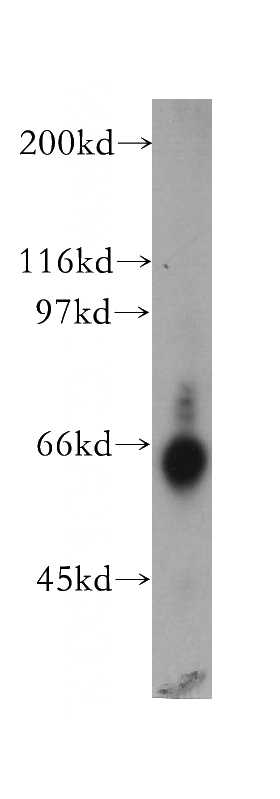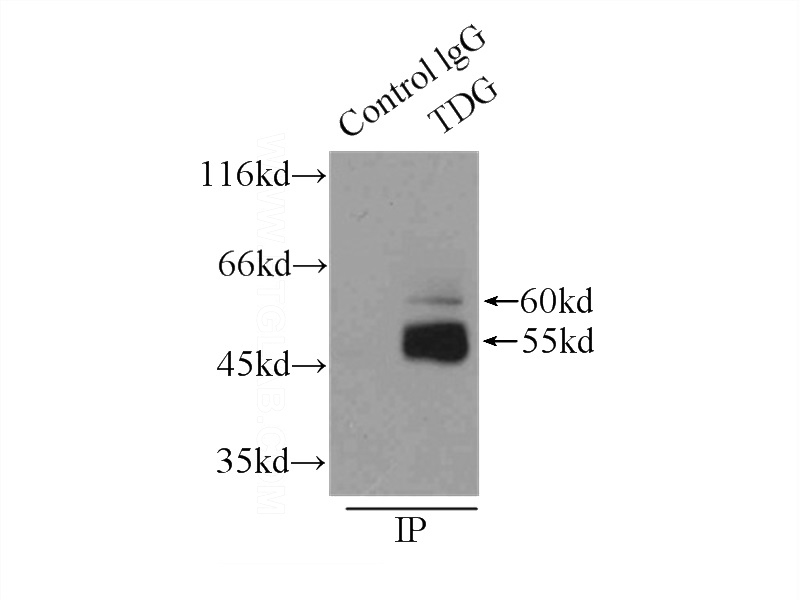-
Product Name
TDG antibody
- Documents
-
Description
TDG Rabbit Polyclonal antibody. Positive IP detected in U-937 cells. Positive WB detected in human brain tissue, HeLa cells, mouse colon tissue, mouse thymus tissue, Raji cells. Observed molecular weight by Western-blot: 60, 86 kDa
-
Tested applications
ELISA, WB, IP
-
Species reactivity
Human,Mouse,Rat; other species not tested.
-
Alternative names
TDG antibody; thymine DNA glycosylase antibody
-
Isotype
Rabbit IgG
-
Preparation
This antibody was obtained by immunization of TDG recombinant protein (Accession Number: NM_003211). Purification method: Antigen affinity purified.
-
Clonality
Polyclonal
-
Formulation
PBS with 0.02% sodium azide and 50% glycerol pH 7.3.
-
Storage instructions
Store at -20℃. DO NOT ALIQUOT
-
Applications
Recommended Dilution:
WB: 1:500-1:5000
IP: 1:200-1:1000
-
Validations

human brain tissue were subjected to SDS PAGE followed by western blot with Catalog No:115922(TDG antibody) at dilution of 1:400

IP Result of anti-TDG (IP:Catalog No:115922, 3ug; Detection:Catalog No:115922 1:400) with U-937 cells lysate 3000ug.
-
Background
TDG belongs to the TDG/mug DNA glycosylase family. TDG corrects G/T mispairs to G/C pairs. It is capable of hydrolyzing the carbon-nitrogen bond between the sugar-phosphate backbone of the DNA and a mispaired thymine. In addition to the G/T, it can remove thymine also from C/T and T/T mispairs in the order G/T >> C/T > T/T. It has no detectable activity on apyrimidinic sites and does not catalyze the removal of thymine from A/T pairs or from single-stranded DNA. It can also remove uracil and 5-bromouracil from mispairs with guanine. RNF4 interacts with and requires the base excision repair enzymes TDG and APE1 for active demethylation (PMID:20696907). TDG is modified by SUMO-1 and SUMO-2/3.The molecular weight of non-modified TDG is 60 kDa and modified TDG is 86 kDa.
-
References
- Hu XV, Rodrigues TM, Tao H. Identification of RING finger protein 4 (RNF4) as a modulator of DNA demethylation through a functional genomics screen. Proceedings of the National Academy of Sciences of the United States of America. 107(34):15087-92. 2010.
- Xu X, Yu T, Shi J. Thymine DNA glycosylase is a positive regulator of Wnt signaling in colorectal cancer. The Journal of biological chemistry. 289(13):8881-90. 2014.
- Sahin U, Ferhi O, Jeanne M. Oxidative stress-induced assembly of PML nuclear bodies controls sumoylation of partner proteins. The Journal of cell biology. 204(6):931-45. 2014.
- Shibata E, Dar A, Dutta A. CRL4Cdt2 E3 ubiquitin ligase and proliferating cell nuclear antigen (PCNA) cooperate to degrade thymine DNA glycosylase in S phase. The Journal of biological chemistry. 289(33):23056-64. 2014.
Related Products / Services
Please note: All products are "FOR RESEARCH USE ONLY AND ARE NOT INTENDED FOR DIAGNOSTIC OR THERAPEUTIC USE"
